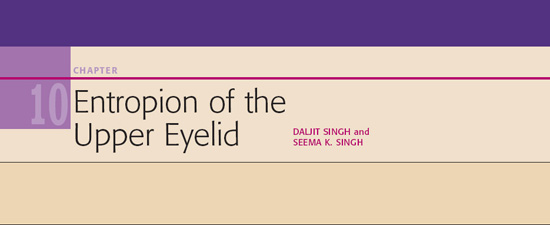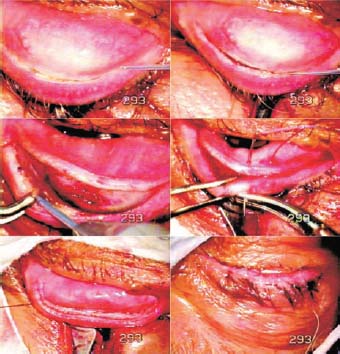
 rachoma is one of the most common causes of upper eyelid entropion and trichiasis. The corneal lesions result either as sequelae of eyelid deformity or from dryness of the eye resulting from partial tototal destruction of secretory elements of the conjunctiva and keratinization of the epithelium.
rachoma is one of the most common causes of upper eyelid entropion and trichiasis. The corneal lesions result either as sequelae of eyelid deformity or from dryness of the eye resulting from partial tototal destruction of secretory elements of the conjunctiva and keratinization of the epithelium.
Entropion and trichiasis cause eye irritation because the affected eyelid rubs against the cornea and conjunctiva. Surgical correction of the lid deformity is important for relief of irritation and to avoid further damage to the eye.
Entropion results from cicatricial contraction of the tarsal conjunctiva, which pulls the intermarginal strip up and in, rounding off the sharp inner edge. This in turn pullson the skin, and the lashes become misdirected, turning inward. The change in the direction of the lashes begins in the hindmost row first. As the severity of the contraction increases, more rows of the cilia turn inward.
The correction of entropion is best done from the conjunctival side, because the incision goes through the scar tissue of the conjunctiva and the nearest part of the tarsal plate. The key operation for entropion of the upper lid is the “inversio tarsi”; this procedure has various modifications of the conjunctival approach to entropion correction. The surgery involvesthe rotation of the distal (lash-bearing) end of the tarsal plate by undermining it with the wedge of the proximal (toward the fornix) endof the tarsal plate and securing it in place by suturing proximal tarsal plate to the undersurface of the skin bearing the lashes.
TECHNIQUE
Anesthesia
Use topical anesthesia for surface anesthesia for the conjunctiva, and infiltrate the lid with proparacaine 1%, which provides good anesthesia. Balloon the lid with anesthetic and apply pressure for a few minutes.
Surgical Technique
- Pass a thick nylon suture close to the upper lid margin and hold it with an artery forceps. The suture acts as a kind of “leash” during the surgery.
- Evert the lid over a Desmarre lid retractor. The conjunctival side of the lid is visible from end to end. The subtarsal sulcus is visible about 1.5 to 2 mm behind the root of the cilia. Its distance fromthe cilia is closer in the middle, but usually increases toward the two ends (Fig. 10.1).
- Use a Fugo blade with a 100- µm tip (used for capsulotomy) at high energy settings. Make an incision at the subtarsal sulcus from end to end. The first pass should be about half depth of the tarsal plate. Press the lid retractor upward to keep the tarsal platestretched. Cut the tarsal plate deeper first in the middle and then on the sides.
- Undermine the entire cut edges of the tarsal plate to separate it from the orbicularis muscle on both sides for about 2 mm, using the same 600- µm tip. The Fugo blade tip maintains hemostasis at the same time. Take care not to damage the roots of the eyelashes.
- Suture with a 5-0 absorbable polyglactin suture. Begin at the lateral edge from the skin surface of the lid. Pass the needle through the skin along the lashes so that the tip emerges from under the distal cut edge of the tarsal plate. On the proximal side, make it to traverse from the anterior to the posterior surface like a whip. Then make the suture traverse back the same way, starting about 3 mm away, avoiding any picking of the orbicularis muscle. Repeat the same steps in a key pattern, until the whole lid margin is covered. Then stretch and tighten the suture between two needle holders, and make it take a bite of the skin to reach the first entry point, where you should tie it.
- Undermine the entire cut edges of the tarsal plate to separate it from the orbicularis muscle on both sides for about 2 mm, using the same 600- µm tip. The Fugo blade tip maintains hemostasis at the same time. Take care not to damage the roots of the eyelashes.

Figure 10.1. The lid is everted using a Desmarre rectractor. Incision is made with the Fugo blade with a 100- µm tip at the subtarsal sulcus and deepened until the tarsal plate is cut. Undermining of the tarsal plate is done on both sides with a 600- µm Fugo blade tip. The cut edges are sutured so that the lid margin bearing the cilia rotates forward.
As you cut the middle part of the plate to full depth, the pressure of the lid spatula separates the cut edges. Then extend the incision on both sides. The lid spatula is the sheet anchor for presenting the stretched tarsal plate for incision and for hemostasis when a lid vessel is cut. You can minimize or even avoid bleeding if you carry out the deepest part of the incision very slowly, so that you do not injure any large blood vessel passing through the orbicularis muscle. Although the pressure of the lid spatula controls the leakage of blood, use a 600- µm Fugo blade tip at the medium power setting to stop bleeding.
Postoperative Management
Apply a dressing for 4 to 5 hours. Prescribe an antibiotic ointment to be used twice a day for 3 weeks. The sutures do not need to be removed; internal sutures are absorbed, and exposed sutures fall off in a couple of weeks.
Suggested Reading
Duke-Elder W. System of ophthalmology, vol. 8. London: Kimpton, 1965.
Kettesy A. Genesis and operation of cicatricial (trachomatous) entropion of the upper lid. Br J Ophthalmol. 1948;32:419–423.
Mukherjee PK, Jain PC. Entropion operation of upper lid in trachoma—a modification of “inversio tarsi” operation. Indian J. Ophthalmol. 1969;17:99–102.
Shukla BR. Surgical consideration in trachoma cases in India. J All-India Ophthalmol Soc. 1964;12:82–84.
Stay updated, free articles. Join our Telegram channel

Full access? Get Clinical Tree


